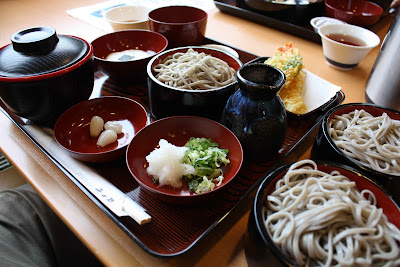It’s been months, literally, since my last blog post, which
was due mainly to an insane work schedule and changes yet again to my area of
residence. I’ve been working the equivalent of two jobs since February of this
year (and in the last 17 months have moved from Hanoi to Akita, to Mui Ne, back to Akita, to Tokyo, and then to Fukui), but it seems I’ve managed to shuck one gig recently and have a somewhat
normal schedule to look forward to. What this means, I hope, is that I can get
back to blogging semi-regularly. I’ll detail the past year or so in a future
post, but for now I’m going to dive into some recent travel and eating…here in
Fukui, Japan, which is in the Hokuriku region of the country and within very
reasonable train distance to some of my favorite places: Kyoto (80 minutes
away) and Kanazawa (40 minutes away).
With the time of year turning cold and gloomy, it’s nice to
turn one’s attention to kouyou, which
refers to the tradition of viewing Japan’s rich autumn foliage. This weekend I
tried to combine some kouyou
viewing with local travel. My first trip was to Eiheiji Temple, which is a
40-minute bus ride (a ¥720-ticket purchased in advance) from Fukui Station (bus
stop #1).
The temple is only 10 miles southeast of Fukui, so if you happen to
have your own transportation you can probably get there in about 25 minutes.
Despite the fact that the temple is one of the most famous tourist destinations
in Fukui prefecture, I didn’t expect it to impress me as much as it did.
It doesn’t compare to Koya-san, but I was more impressed with Eiheiji than any
of the temples I’ve seen in Kyoto and Nara. It doesn’t rank with Izu Shrine in
terms of its historic importance, but I think I enjoy Eiheiji even more
because of how beautifully it blends in with the natural surroundings.
Eiheiji is important architecturally for that reason, in
fact, but even more important is its designation as the head temple of the Soto
Zen sect, which was founded in 1244 by Dogen Zenji. The temple premises cover
nearly 100,000 square meters, and the grounds are filled with various types of
ancient pines, Japanese maples, gingkoes, cryptomeria cedars, and other blazingly-leafed
trees.
Another important feature of the temple is its function as a training
ground for more than 200 priests. One sees young priests, clad in black robes
and with their heads shaved, walking and working in the temple. With advanced
reservations, you can spend the night here for what is supposedly quite
rigorous zazen training. I call tell you
without hesitation that I never considered doing this.
The main temple is composed of several tiers that climb up
the mountain, and as it climbs, visitors must climb, too.
Some of the stairs
seemed never-ending, and the corridors that connected them were almost mazelike
in their intricacy.
In a way it was lucky that Fukui’s ceaseless rain at this
time of year let up long enough for me to visit Eiheiji. The rain deepened the
colors of the already-rich foliage, as well as the temple’s wooden construction
and also the stone walkways.
Rain hung for two or three hours off of branches
and leaves like dewdrops. It probably also thinned out the crowds, though I by
no means had the temple to myself.
After two or three hours here it was time for lunch, and, as
visitors are bound to notice on the drive to the temple, the surrounding area,
called Echizen, is famous for its soba (buckwheat noodles). Echizen is a large
area that is associated most of all, probably, with crabs—one single Echizen
male crab will throw you back at least ¥10,000 (over $120)—and secondly with
soba. After walking a couple minutes down the mist-shrouded mountain road, and
passing some of the biggest dango
(grilled mochi dumpling) I’ve ever seen, I settled for a three-soba set lunch.
The soba varieties included Echizen soba (plain soba), tororo soba (grated yam soba), and tempura soba. The meal
came with miso soup, pickled onion bulbs, and free tea and cost ¥800 (less than
$10).



























Did you ever visit Eiheiji again in the winter?
ReplyDeleteRichardo: No, I never made it back, unfortunately. That just gives me another excuse to return!
ReplyDelete